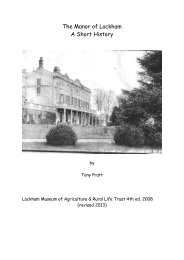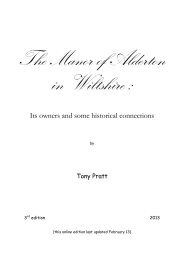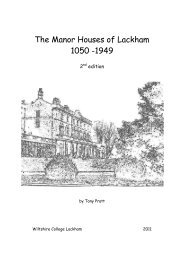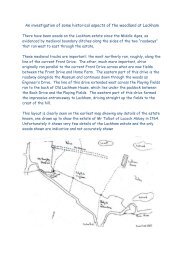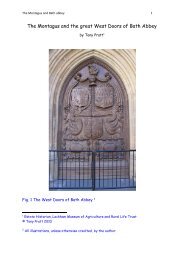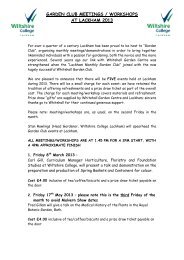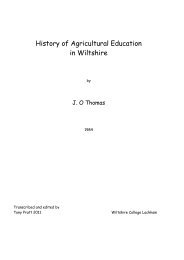Vol 1: The Bluets - Lackham Countryside Centre
Vol 1: The Bluets - Lackham Countryside Centre
Vol 1: The Bluets - Lackham Countryside Centre
You also want an ePaper? Increase the reach of your titles
YUMPU automatically turns print PDFs into web optimized ePapers that Google loves.
<strong>The</strong> <strong>Bluets</strong> 55<br />
It is noted that the instruction here was to destroy the houses at<br />
Knepp, not the Castle itself. It may have been spared because hostilities<br />
ceased after June 15 1215 when, at Runnymede, King John accepted the<br />
terms in the document known as the Articles of the Barons. This<br />
document was further revised over the next few days, until both John<br />
and the barons accepted the provisions embodied within it, and it became<br />
known as the Magna Carta (the Great Charter).<br />
John almost immediately appealed against the charter to the pope,<br />
who took the king's side, and yet another civil war ensued. John<br />
captured Rochester castle and devastated the northern counties<br />
and the Scottish border lands. But then Prince Louis of France<br />
(later King Louis VIII), at the barons' request, invaded England.<br />
Knepp Castle was still in existence in 1216, when the French invasion<br />
of southern England was in full swing, with Roland still in charge of<br />
the forests at Knepp. This is clear because King John was looking<br />
for war engines and instructed that Roland should<br />
Cause to be made, without delay, in the forest of Knappe as<br />
many good engine-towers called Turkese 220 as you<br />
220<br />
This term is difficult but “the mention of a new 'Turkish' engine just prior<br />
to Henry III's reign and the 'great engines' of Louis' invasion of England in<br />
1216 have been accepted as evidence for the advent of the heavy counterweight<br />
trebuchet in the West. 'Turkish' engines …[probably] referred to traction<br />
trebuchets” http://medievalhistory.mysite.wanadoo-members.co.uk/chap3.html<br />
.<br />
“<strong>The</strong> TRACTION TREBUCHET was a smaller, shorter range and more portable<br />
machine that was "human powered", and therefore, was much easier to<br />
construct and move from place to place and siege to siege. Instead of a massive<br />
counterweight, the "Traction Treb" employed a group of people pulling down on<br />
ropes attached to the rear or short end of the Virga (throwing arm) to provide<br />
the weapon's throwing power. <strong>The</strong> mechanical action was the same; but the<br />
weight of the projectiles was much less and the rate of discharge was much<br />
faster, up to several shots a minute, as opposed to several minutes to "tens" of<br />
minutes per shot with a large counterpoise type machine.<br />
<strong>The</strong> smallest Traction Trebs could be powered by the weight and pulling strength<br />
of one person using a single rope; but most were designed and sized to utilize<br />
from 20 to 100 men and/or women, generally two per rope, using their combined<br />
weight and pulling strength to power the weapon. <strong>The</strong>se Teams would frequently<br />
be local non-combatants (women, children, older men) assisting in the siege or in<br />
the defense [sic] of their town. Traction Trebuchets had a range of from 200 to<br />
well over 300 feet (60 to 100+ meters) casting weights up to 130 pounds (60kg )



